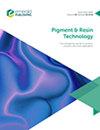Optimization and assessment on indirect electrochemical reduction of indigo
IF 1.3
4区 材料科学
Q3 CHEMISTRY, APPLIED
引用次数: 2
Abstract
Purpose An indirect electrochemical reduction and dyeing with indigo were carried out here to solve problems of low dye reduction rate and poor dyeing depth in the current electrochemical dyeing process. Design/methodology/approach Response surface analysis tests were performed to evaluate the effects of ferrous sulfate concentration, medium concentration, sodium hydroxide concentration and reduction time on the reduction efficiency of indirect electrochemical reduction of indigo. Findings The conditions obtained by design-expert optimization showed that the concentration of FeSO4·7H2O has the most significant effect on the reduction performance of dye liquor. Under the optimized electrochemical reduction dyeing process, the rate of dye reduction could be reached 91.21 per cent and the K/S value of indirect electrochemical dyeing of indigo can be achieved to 12.96, which is increased by about 9.56 per cent compared with that of Na2S2O4 dyeing with the same color fastness basically. Research limitations/implications The recyclability and biodegradability of the dye remain to be explored. Practical implications The strategy presented here can be developed to replace a substantial part of electrochemical dyeing with optimized product quality and reduced environmental pollution in denim production. Social implications The strategy presented here can be developed to replace a substantial part of electrochemical dyeing with optimized product quality and reduced environmental pollution in denim production. Originality/value Application of the Fe(II)-DGS-Abal B complex media system in the indirect electrochemical reduction of indigo.靛蓝间接电化学还原工艺的优化与评价
目的针对目前电化学染色工艺中染料还原率低、染色深度差的问题,进行了靛蓝间接电化学还原染色。设计/方法/方法通过响应面分析试验,考察硫酸亚铁浓度、介质浓度、氢氧化钠浓度和还原时间对靛蓝间接电化学还原效率的影响。结果通过设计专家优化得到的条件表明,FeSO4·7H2O浓度对染料液还原性能的影响最为显著。在优化后的电化学还原染色工艺下,靛蓝的染料还原率可达91.21%,间接电化学染色的K/S值可达12.96,与相同色牢度的Na2S2O4染色相比,基本提高了约9.56%。研究局限/启示染料的可回收性和生物降解性仍有待探索。实际意义本文提出的策略可以在优化产品质量和减少牛仔生产环境污染的情况下取代大部分电化学染色。社会意义本文提出的策略可以在优化产品质量和减少牛仔生产中的环境污染的情况下取代大部分电化学染色。Fe(II)-DGS-Abal B复合介质体系在靛蓝间接电化学还原中的应用。
本文章由计算机程序翻译,如有差异,请以英文原文为准。
求助全文
约1分钟内获得全文
求助全文
来源期刊

Pigment & Resin Technology
工程技术-材料科学:膜
CiteScore
2.80
自引率
21.40%
发文量
91
审稿时长
>12 weeks
期刊介绍:
The journal looks at developments in: ■Adhesives and sealants ■Curing and coatings ■Wood coatings and preservatives ■Environmentally compliant coating systems and pigments ■Inks for food packaging ■Manufacturing machinery - reactors, mills mixing and dispersing equipment, pumps ■Packaging, labeling and storage ■Plus topical features and news on materials, coatings, industry people, conferences, books and so on ■Raw materials such as pigments, solvents, resins and chemicals ■Testing equipment and procedures
 求助内容:
求助内容: 应助结果提醒方式:
应助结果提醒方式:


